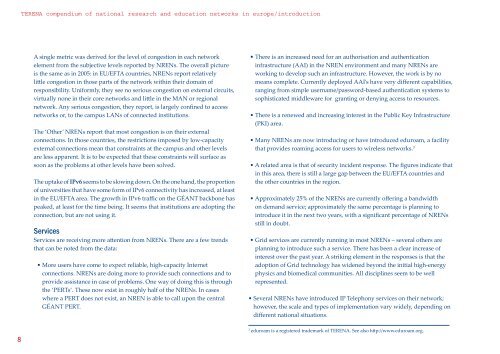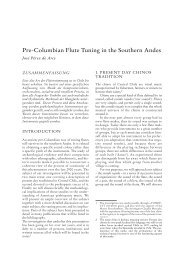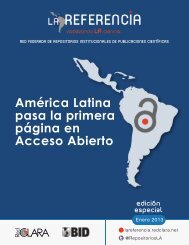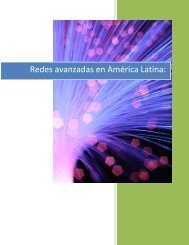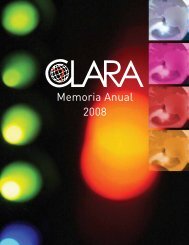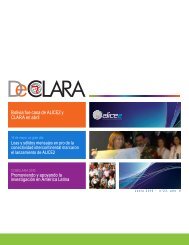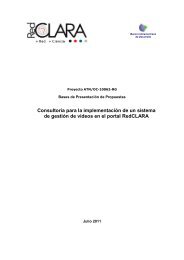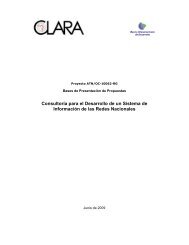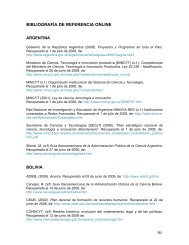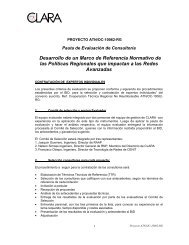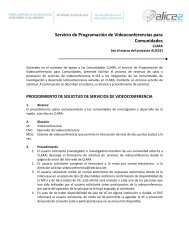full PDF version (2.1 MB) - Terena
full PDF version (2.1 MB) - Terena
full PDF version (2.1 MB) - Terena
- No tags were found...
You also want an ePaper? Increase the reach of your titles
YUMPU automatically turns print PDFs into web optimized ePapers that Google loves.
TERENA compendium of national research and education networks in europe/introductionA single metric was derived for the level of congestion in each networkelement from the subjective levels reported by NRENs. The overall pictureis the same as in 2005: in EU/EFTA countries, NRENs report relativelylile congestion in those parts of the network within their domain ofresponsibility. Uniformly, they see no serious congestion on external circuits,virtually none in their core networks and lile in the MAN or regionalnetwork. Any serious congestion, they report, is largely confined to accessnetworks or, to the campus LANs of connected institutions.The ‘Other’ NRENs report that most congestion is on their externalconnections. In those countries, the restrictions imposed by low-capacityexternal connections mean that constraints at the campus and other levelsare less apparent. It is to be expected that these constraints will surface assoon as the problems at other levels have been solved.The uptake of IPv6 seems to be slowing down. On the one hand, the proportionof universities that have some form of IPv6 connectivity has increased, at leastin the EU/EFTA area. The growth in IPv6 traffic on the GÉANT backbone haspeaked, at least for the time being. It seems that institutions are adopting theconnection, but are not using it.ServicesServices are receiving more aention from NRENs. There are a few trendsthat can be noted from the data:• More users have come to expect reliable, high-capacity Internetconnections. NRENs are doing more to provide such connections and toprovide assistance in case of problems. One way of doing this is throughthe ‘PERTs’. These now exist in roughly half of the NRENs. In caseswhere a PERT does not exist, an NREN is able to call upon the centralGÉANT PERT.• There is an increased need for an authorisation and authenticationinfrastructure (AAI) in the NREN environment and many NRENs areworking to develop such an infrastructure. However, the work is by nomeans complete. Currently deployed AAI’s have very different capabilities,ranging from simple username/password-based authentication systems tosophisticated middleware for granting or denying access to resources.• There is a renewed and increasing interest in the Public Key Infrastructure(PKI) area.• Many NRENs are now introducing or have introduced eduroam, a facilitythat provides roaming access for users to wireless networks. 3• A related area is that of security incident response. The figures indicate thatin this area, there is still a large gap between the EU/EFTA countries andthe other countries in the region.• Approximately 25% of the NRENs are currently offering a bandwidthon demand service; approximately the same percentage is planning tointroduce it in the next two years, with a significant percentage of NRENsstill in doubt.• Grid services are currently running in most NRENs – several others areplanning to introduce such a service. There has been a clear increase ofinterest over the past year. A striking element in the responses is that theadoption of Grid technology has widened beyond the initial high-energyphysics and biomedical communities. All disciplines seem to be wellrepresented.• Several NRENs have introduced IP Telephony services on their network;however, the scale and types of implementation vary widely, depending ondifferent national situations.83eduroam is a registered trademark of TERENA. See also hp://www.eduroam.org.


